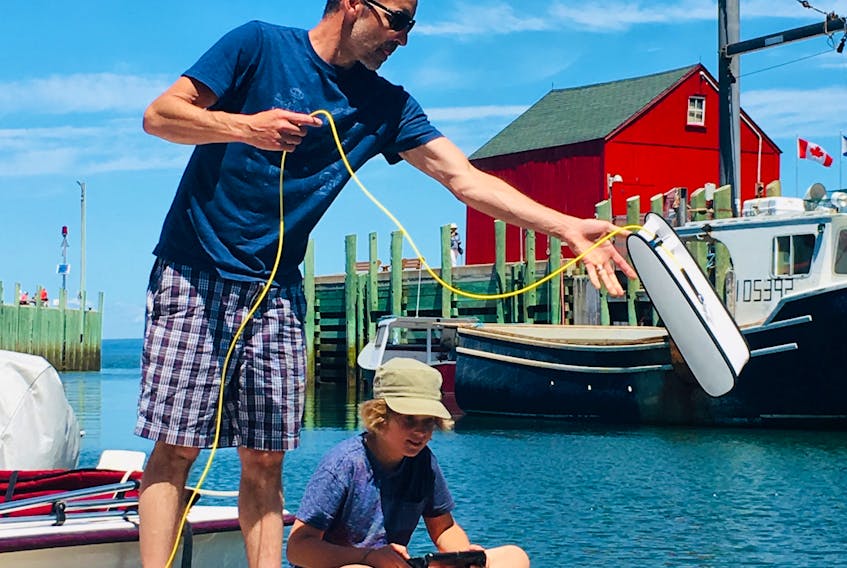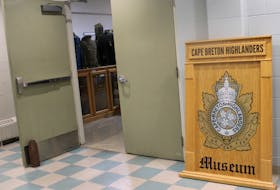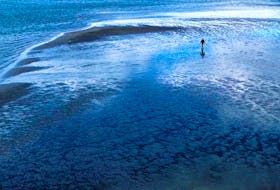HALLS HARBOUR, N.S. — Melissa Laforge came back to Nova Scotia with her husband, Charles, to explore their Acadian heritage in Grand Pré.
That exploration has taken a turn for the sea.
Laforge has been scouring the depths of the Bay of Fundy with a shoebox-sized underwater remotely operated vehicle (ROV).
The couple owns summer property in Nova Scotia, and for the last few years have been regularly visiting the province, hearing all sorts of local lore about what is in the bay.
Curiosity piqued by stories of shipwrecks, lost weirs and buried treasure, Laforge wanted to see for herself what was out there.
“We have a small boat out of Halls Harbour (the Linda-Lee). We set off on kind of an expedition,” Laforge said. “When I spoke with Nova Scotia Museum, they said those local tales I heard represent a small fraction of what’s out there.”
Laforge made a pitch to Open Explorer, a company that allows people to buy into their project or apply for grants to purchase underwater ROVs.
The rest was history, and Laforge and her husband, with their daughters, Marah and Pearle and son Blaise, stood on the deck of their boat, watching on a tablet as their ROV descended into the depths.
WHAT LIES BENEATH THE WAVES?
Underneath the waves and tides of the Bay of Fundy, there were no casks of treasure or elaborate shipwrecks straight out of a fairy tale – but there were some interesting sights.
An inquisitive creature was spotted not far from Halls Harbour, gaping into the camera, looking almost as if it is grinning. Whether this creature was a dogfish or blue shark is open to interpretation.
“When we posted the picture to social media, someone said it was a blue shark and a lot of people contradicted them, said it was a dogfish and stated their reasons,” Laforge said. “I remember catching dogfish and they were the size of my arm, they were not that length.”
Kings County News contacted Trevor Avery, a biology, math and statistics professor at Acadia University to put an end to the speculation. He noted that given the angle of the picture the ROV captured, it could be either.
“It’s difficult to tell without a scale or view of the dorsal fin,” Avery wrote in an email. “Dogfish have prominent spines in front of their dorsal and pectoral fins. Blue sharks can get very large, but smaller ones have been caught in the bay (even in the Minas Basin).”
Laforge also observed the presence of large, open stretches of empty seafloor.
“They were nearly empty,” Laforge said, noting they also found a large, abrupt clump of rocks with nothing around them.
Laforge noted the anomalous pile of boulders on the sea floor was likely old ballast stones from old sunken ships, sitting where they sunk long after the vessels they once weighted down disintegrated.
One memory that Laforge most fondly recalls occurred on the way back up to the surface. As they dragged the ROV back up to the surface, the camera caught a vertically-inclined fish basking near the surface.
“It was an amazing encounter, and it made for some really cool footage,” Laforge said. “Sunfish are vertical, not horizontal. We swam around it, face-to-face with it. It’s about two minutes of footage of us hanging out with the sunfish.”
Laforge noted there were moments, she and Charles were surprised by what they didn’t find. There wasn’t nearly as much trash under the water as Laforge expected to see.
“We also didn’t see any lobster, even though we weren’t far from an area just off the harbour where there is active lobster fishing,” Laforge said.
FRIENDLY FOLKS
One of the most valuable things Laforge found during her expedition wasn’t even underwater – it was in the communities near the Bay of Fundy, where she found an abundance of helpful people, who sought to assist in identifying what she found.
“The strength of the expedition comes from opening up the enquiry to the community,” Laforge said. “There were so many people in the community actively working to help us identify what we found.”
Laforge noted she intends to upload all the footage she has onto her website, to keep open the spirit of enquiry, consulting local knowledge to understand her findings all the better.
“Tapping into the community for bits of feedback and information has been very important,” she added.
UNPREDICTABLE BAY
Exploring what lurks beneath the waves can be a challenging pursuit in the Bay of Fundy, given the unpredictable water and weather conditions.
“Based on the tides alone, it’s one of the most challenging places in the world to access,” Laforge said. “Between the currents, the massive tide changes and visibility changes that come as soon as the tides shift, it was interesting.”
Laforge could only get out on the water to deploy the ROV for about one and a half to two hours at a time.
The challenging conditions made for a learning experience. Laforge said they operated in windows of time when the weather and visibility were just right.
“The currents, the tide and the weather have to cooperate,” Laforge said. “Those things can be limited by time. And in that window of time, we’d better hope there isn’t fog.”
Even when the weather and tides are cooperating, accounting for the force of drag on the line that attaches the camera to the boat was also an issue. Laforge noted she has to be conscious of where the ROV is in relation to the boat. A lot of observing what is under the water entails fighting the drag of the currents versus the drift of their craft. Because of that drag and the speed at which it pulled the ROV, interpreting footage can, occasionally, be a challenge.
“I think a 16-year-old video game player could probably navigate down there, with that drift better than I,” Laforge said.
Although the window of opportunity to continue exploring the area is closing as summer winds down, Laforge stressed that she and Charles will be returning for more underwater exploring next summer.









